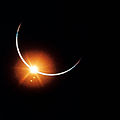On Thursday, October 23 there was a partial solar eclipse. Around the world there are myths and superstitions that revolve around the solar eclipse.
The most common theme around an eclipse is a disruption of established order. Vietnamese, viking and ancient Chinese describe the eclipse as a time when animals eat the sun. The earliest word for an eclipse is shih, meaning “to eat” in Chinese.
Always, there is a way for people to end the eclipse. The Vietnamese and many others believed that if they banged on pots and pans or played the drums the creatures would be scared away. The Batammaliba people who live in West Africa see the eclipse as a time to come together and solve old feuds and make amends; a tradition seen as a teaching moment.
In modern times, a misconception is that you cannot look at the sun when it is completely covered during a total eclipse. E.C. Krupp, director of Griffith Observatory in California debunked the myth, as long as the sun is completely covered, it is safe to look at.
There are four solar eclipses in 2015, three of them will be visible in North America. A total eclipse will be visible in western North America on March 20. A partial eclipse on April 4 and a total eclipse on September 28 will be visible to all of North America.














Serena Bettis • Jan 27, 2015 at 1:45 pm
The article feels really choppy, especially the beginning. Also, I think Viking needs to be capitalized, and shouldn’t there be a comma after it?
Overall, however, I really like the topic of the article, it’s a fun, interesting thing to know about.
Gio Figueroa • Dec 4, 2014 at 2:43 pm
I like the brief history about solar eclipse misconceptions and i also like the info about up coming solar eclipses in 2015. It really made sense to include all of the info that was in this article. Great Work!!
Jason Alexander • Dec 4, 2014 at 2:24 pm
Good job on providing background history and information on various superstitions on solar eclipses